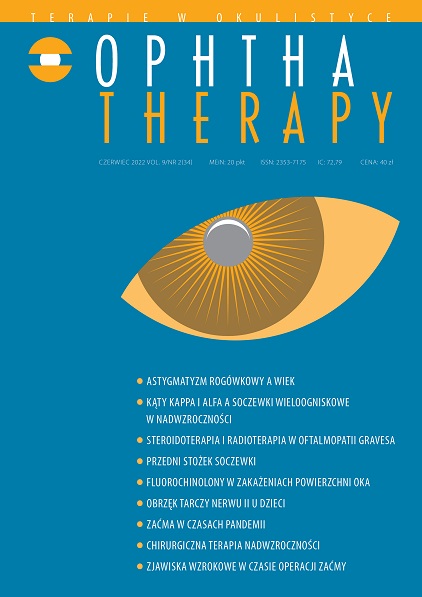Pacjent z zaćmą – obserwacje po 2 latach pandemii i perspektywy na przyszłość Artykuł przeglądowy
##plugins.themes.bootstrap3.article.main##
Abstrakt
Zaćma to choroba polegająca na całkowitym lub częściowym zmętnieniu naturalnej soczewki. W okresie pandemii obserwowano znaczny spadek liczby wykonywanych operacji usunięcia zaćmy w stosunku do lat wcześniejszych, wynikający z obawy przed zachorowaniem i o bezpieczeństwo wykonywanych zabiegów. Usunięcie zaćmy powinno być przeprowadzone u pacjentów, u których pogorszenie ostrości widzenia ma wpływ na wykonywanie czynności życiowych lub zawodowych. Okres pandemii spowodował, że część pacjentów zgłasza się w bardziej zaawansowanym stadium zaćmy, co prowadzi do obniżenia komfortu ich życia. Taki zabieg obarczony jest większym ryzykiem powikłań operacyjnych i dłuższą rekonwalescencją. Rozwój nowych technologii soczewek wewnątrzgałkowych, wydłużenie średniej długości życia, a także zmiana stylu życia oraz większa aktywność zawodowa osób w starszym wieku przyczyniają się do coraz częstszego wyboru przez pacjentów soczewek wewnątrzgałkowych z grupy premium. Soczewki te pozwalają osiągnąć satysfakcjonującą nieskorygowaną ostrość widzenia nie tylko do dali, ale także do bliży oraz odległości pośredniej.
Pobrania
##plugins.themes.bootstrap3.article.details##

Utwór dostępny jest na licencji Creative Commons Uznanie autorstwa – Użycie niekomercyjne – Bez utworów zależnych 4.0 Międzynarodowe.
Copyright: © Medical Education sp. z o.o. License allowing third parties to copy and redistribute the material in any medium or format and to remix, transform, and build upon the material, provided the original work is properly cited and states its license.
Address reprint requests to: Medical Education, Marcin Kuźma (marcin.kuzma@mededu.pl)
Bibliografia
2. Wytyczne SCOP_zaćma_aktualizacja.09.2021.pdf (access: 10.04.2022).
3. Załącznik do wytycznych operacyjnego leczenia zaćmy u pacjentów z astygmatyzmem rogówkowym (access: 10.04.2022).
4. Kanclerz P, Toto F, Grzybowski A et al. Extended Depth-of-Field Intraocular Lenses: An Update. Asia Pac J Ophthalmol (Phila). 2020; 9(3): 194-202. http://doi.org/10.1097/APO.0000000000000296.
5. Leyland M, Pringle E. Multifocal versus monofocal intraocular lenses after cataract extraction. Cochrane Database Syst Rev. 2006; 4. http://doi.org/10.1002/14651858.CD003169.pub2.
6. Shah S, Peris-Martinez C, Reinhard T et al. Visual Outcomes After Cataract Surgery: multifocal Versus Monofocal Intraocular Lenses. J Refract Surg. 2015; 31(10): 658-66. http://doi.org/10.3928/1081597X-20150611-01.
7. Greenstein S, Pineda R. The Quest for Spectacle Independence: A Comparison of Multifocal Intraocular Lens Implants and Pseudophakic Monovision for Patients with Presbyopia. Semin Ophthalmol. 2017; 32(1): 111-5. http://doi.org/10.1080/08820538.2016.128400.
8. Yamauchi T, Tabuchi H, Takase K et al. Comparison of Visual Performance of Multifocal Intraocular Lenses with Same Material Monofocal Intraocular Lenses. PLoS One. 2013; 8(6): e68236. http://doi.org/10.1371/journal.pone.0068236.
9. Kim CY, Chung SH, Kim TI et al. Comparison of Higher-Order Aberration and Contrast Sensitivity in Monofocal and Multifocal Intraocular Lenses. Yonsei Med J. 2007; 48(4): 27-633. http://doi.org/10.3349/ymj.2007.48.4.627.
10. Hawker MJ, Madge SN, Baddeley PA et al. Refractive expectations of patients having cataract surgery. J Cataract Refract Surg. 2005; 31(10): 1970-5. http://doi.org/10.1016/j.jcrs.2005.03.065.
11. Alió JL, Plaza-Puche AB, Fernandez-Buenaga R et al. Multifocal Intraocular Lenses: An Overview on the Technology, Indications, Outcomes, Complications and their Management. Survey of Ophthalmol. [In Review Process].
12. Alió JL, Pikkel J. Multifocal intraocular lenses: The art and the practice. Essentials in Ophthalmology. Switzerland: Springer International Publishing; 2014.
13. Kohnen T. First implantation of a diffractive quadrafocal (trifocal) intraocular lens. J Cataract Refract Surg. 2015; 41: 2330-2.
14. Kohnen T, Herzog M, Hemkeppler E et al. Visual performance of a quadrifocal (trifocal) intraocular lens following removal of the crystalline lens. Am J Ophthalmol. 2017; 184: 52-62.
15. RayOne Trifocal (access: 10.04.2022).
16. Sulcoflex Trifocal (access: 10.04.2022).
17. Maurino V, Allan BD, Rubin GS et al. Moorfields IOL Study Group. Quality of vision after bilateral multifocal intraocular lens implantation: A randomized trial – AT LISA 809M versus AcrySof ReSTOR SN6AD1. Ophthalmology. 2015; 122: 700-10.
18. Denoyer A, Le Lez ML, Majzoub S et al. Quality of vision after cataract surgery after Tecnis Z9000 intraocular lens implantation: Effect of contrast sensitivity and wavefront aberration improvements on the quality of daily vision. J Cataract Refract Surg. 2007; 33: 210-6.
19. Savini G, Balducci N, Carbonara C et al. Functional assessment of a new extended depth-of-focus intraocular lens. Eye (Lond). 2019; 33: 404-10.
20. Savini G, Schiano-Lomoriello D, Balducci N et al. Visual performance of a new extended depth-of-focus intraocular lens compared to a distance-dominant diffractive multifocal intraocular lens. J Refract Surg. 2018; 34: 228-35.
21. Kohnen T, Suryakumar R. Extended depth-of-focus technology in intraocular lenses. J Cataract Refract Surg. 2020; 46(2): 298-304. http://doi.org/10.1097/j.jcrs.0000000000000109.
22. Alcon Vision LLC. Acrysof IQ Vivity Extended Vision IOL Product Information. 2019. (access: 11.04.2022).
23. RayOne EMV. Monovision. Enhanced* (access: 11.04.2022).
24. Alio JL, Plaza-Puche AB, Férnandez-Buenaga R et al. Multifocal intraocular lenses: An overview. Surv Ophthalmol. 2017; 62: 611-34.
25. Mester U, Vaterrodt T, Goes F et al. Impact of personality characteristics on patient satisfaction after multifocal intraocular lens implantation: Results from the “happy patient study”. J Refract Surg. 2014; 30: 674-8.
26. Mester U, Vaterrodt T, Goes F et al. Impact of personality characteristics on patient satisfaction after multifocal intraocular lens implantation: results from the “happy patient study”. J Refract Surg. 2014; 30: 674-8.
27. Mamalis N, Brubaker J, Davis D et al. Complications of foldable intraocular lenses requiring explantation or secondary intervention – 2007 survey update. J Cataract Refract Surg. 2008; 34: 1584-91.
28. Kamiya K, Hayashi K, Shimizu K et al. Multifocal intraocular lens explantation: A case series of 50 eyes. Am J Ophthalmol. 2014; 158: 215-20.e1.
29. de Vries NE, Webers CA, Touwslager WR et al. Dissatisfaction after implantation of multifocal intraocular lenses. J Cataract Refract Surg. 2011; 37: 859-65.
30. Savini G, Hoffer KJ, Lombardo M et al. Influence of the effective lens position, as predicted by axial length and keratometry, on the near add power of multifocal intraocular lenses. J Cataract Refract Surg. 2016; 42: 44-9.
31. Muzyka-Woźniak M. Soczewki typu premium – dla kogo są przeznaczone i czy są skuteczne? Okulistyka po Dyplomie. 2020; 4: 18-26

